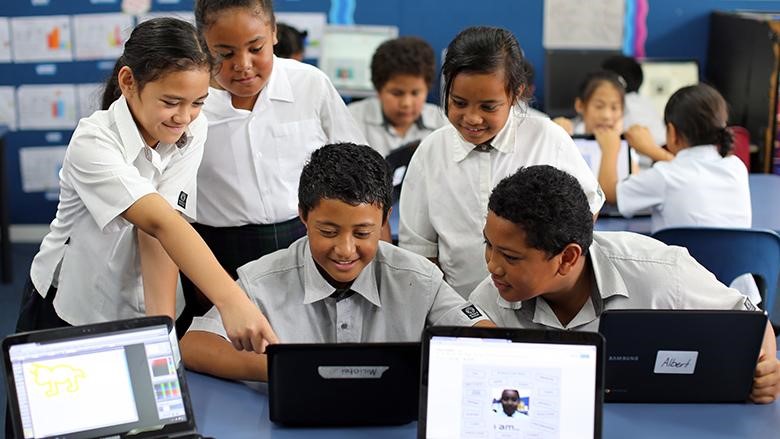Supporting education in your community
Spark Foundation runs a programme called Spark Jump.
This programme brings heavily subsidised broadband to school-age children whose families can’t afford commercial home broadband services.
Spark Jump is one of a series of Spark’s community initiatives involving education. To find out more about Spark’s interest in education and supporting programmes like Manaiakalani, we spoke with Lynne LeGros, General Manager of Spark Foundation.
Q: Spark has been involved in education initiatives for many years. What’s behind that drive and why is it so important?
A: We believe that education unlocks so many of the opportunities in life. So if we invest in our kids, and make sure they have the opportunity of a great education that gets them into learning, everything else will unfold from there. To that end, Spark Foundation looks at how to bring Spark’s vision of ‘unleashing the potential of all New Zealanders’ to life through a number of education-focused programmes.
We’ve chosen to support philanthropic, community and charitable organisations that ‘mirror Spark’s DNA’. Programmes that are digital, innovative and transformational. That aim led us to the Manaiakalani Education Trust with whom we’ve partnered for four years to date.
Manaiakalani began in 2007 with a mostly low-income group of seven schools in Tamaki, Auckland. The programme transforms teaching and learning methods, significantly improving education achievement for the students of the participating schools. Digital learning proved to be the ‘hook’ so it was a good match for Spark. They’re completely re-engineering the science of teaching and the programme now includes 12 schools.
People may think that we’re behind the hardware and connectivity but our funding goes into the evidence-based research that’s carried out by the Woolf Fisher Research Centre at The University of Auckland. This research analyses the programme’s success and helps make a case for further adoption of this type of approach to digital education. Spark is also behind Spark Manaiakalani Innovative Teachers that supports teachers who are conducting inquiries into innovation in teaching.
Q: What have you observed at Manaiakalani schools and how did those results lead to the development of Spark Jump?
A: Manaiakalani results are amazing. The children are so engaged in what and how they're learning. You've never seen so many confident, capable, articulate children and we're talking from the 5-year-olds onwards. They look you in the eye, they shake your hand and say 'welcome to our school'. They believe in themselves and through their blogging they're sharing their learning with the world and they get people from around the world commenting, as well as mum and dad and uncle and auntie.
Through our work with the Manaiakalani Education Trust, we realised that of course learning exists beyond school and that we could use our technology and capabilities to help bridge the digital divide in New Zealand.
There are many households here that don't have the internet and that does mean kids can't do their homework at home. It also means that mum and dad can’t share in learning when that learning is in a digital environment and that these kids may not succeed at the same rate as those in families who do have internet.
All this led us to develop Spark Jump and offer families an affordable way to bring the internet into their homes. We spent a lot of time on development this year and trialled it for three months with families in Hornby, Christchurch and Mt Roskill, Auckland.
Spark Jump isn’t a product you can buy from Spark directly. We’re working with school clusters and organisations like Computers in Homes to identify families who will benefit.
Eligibility is really simple. It's a family that’s been recommended by one of our third-party partners with school age children and no internet access in their home. Because it’s delivered through our wireless broadband, Spark Jump does require suitable 4G coverage where the family lives. It’s $15 for 30GB on a pay-as-you-go basis when you have funds available. There’s no contract, and the family gets the modem for free which means it's very flexible.
The data amount might seem modest but that’s quite a lot in terms of education purposes. We know families will probably use it for wider internet use and that’s their choice, however we are very clear on the intent of the product to support education and learning.
This isn’t about getting people to switch providers. We’re seeking to reach people who aren’t already in the broadband market because they can’t afford it. This is a genuine offer by Spark to make the internet affordable for a specific audience.
Q: What does success look like for Spark Jump?
A: We're keen to see 5,000 Spark Jump connections in this financial year that runs through the end of June 2017. We’re also working on processes in this first year to make sure the programme is scalable so we can bring on more partners to reach families across New Zealand.
Another success measure will be anecdotal – hearing that Spark Jump is making a difference. We don't have a formal way to measure but it's what we expect to hear. And we've already heard it in the trials. Children were doing more homework (and were happy to do it) because they could do it at home as opposed to having to do it at the library.
Q: The Manaiakalani Education Trust and Spark Jump are quite transformational. How do you see technology playing an enabling role in other community segments?
A: Spark is committed to the future of New Zealand and unleashing the potential of New Zealanders. Today, in a modern, digital world, if you don't have access to the internet or don’t have the skills and confidence to use it, we do believe you are left out of the loop and can be isolated or left behind. This can happen with children as well as older people.
We’re involved with Age Hackers, a group of tech-savvy seniors who blog about their experiences with technology in order to show that age is no barrier to doing things things online and being a digital citizen. Using Facebook or watching a TED Talk or booking a trip online – these are things that many of us take for granted as just how we live our lives, interact with others and access information, but it is big change for some and we want to help people of all ages be comfortable with technology and the opportunities it brings.
And look at what Dr Lance O’Sullivan is doing with technology in community health. His iMOKO app is helping school volunteers identify health issues in children who may not get them addressed otherwise. In this case technology is definitely a joiner and enabler.
There’s no industry that technology can't transform in some way – it’s just that we may not have dreamed it up yet.
Q: If I’m inspired by what I’ve read and want to get my business involved in our community, where do you suggest I start?
A: I think the opportunity for mentoring and being a positive role model is huge. If you can volunteer at a school or offer internships that get children thinking 'what is work like?', 'what happens in an office?', or 'how do I conduct myself?', they can be better prepared.
Businesses can also share their expertise and values. For instance, Spark is a technology company. With Spark Jump, we've created a product that’s subsidised to help a community issue. We've married up our desire to be a generous, community-oriented business with our core competency. That, some would say, is the most powerful way that you do giving as a business.
Take some time to work out what you’re good at and how you can use that skill to help society.
Learn more
The Spark Foundation is a registered charity funded by Spark. It's governed independently by a board of trustees.


